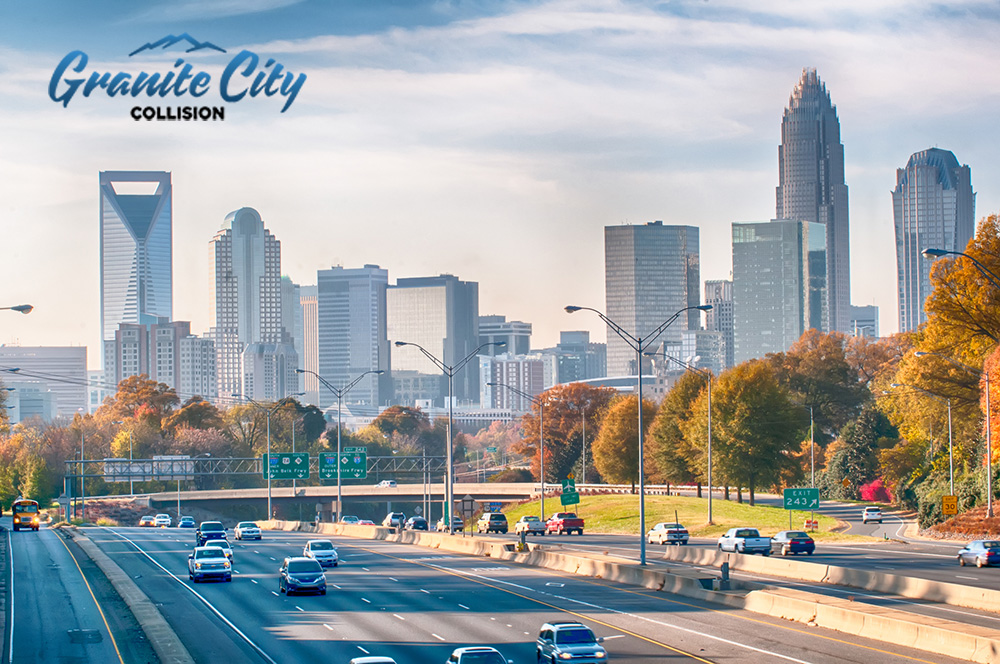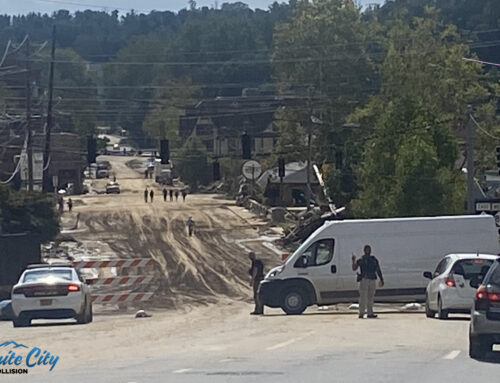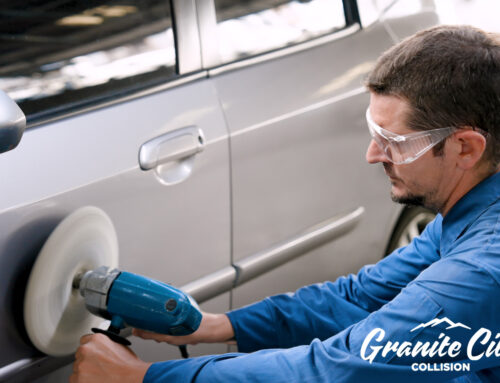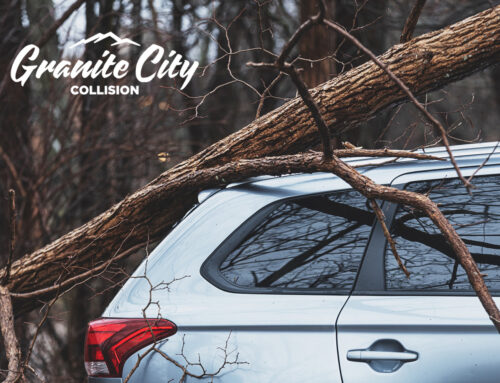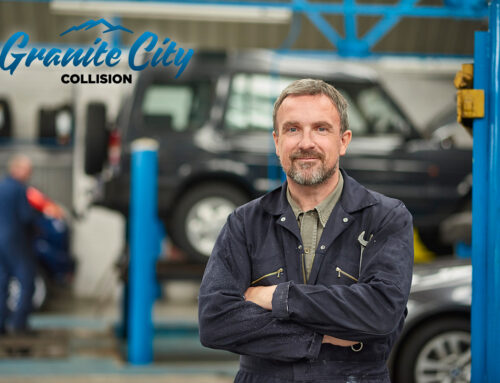Granite City Collision
1935 Rockford Street
Mount Airy, NC 27030
336-786-2119
It’s a story as old as time. You’re running late and find yourself speeding to make up for lost time — or perhaps you just enjoy the feeling of freedom that comes with driving fast.
Sure, it may not seem like such a big deal; but when it comes to auto-body collision work, even slight increases in speed can have potentially deadly consequences. It doesn’t matter whether you’re cruising city streets or navigating your way through winding roads — anything above the posted speed limit increases your risk factors exponentially if an accident should occur, making prevention more important than ever before.
Below, Granite City Collision explores why drivers need to practice slowing down and how speed impacts collisions involving cars and humans alike!
What Is a Collision?
Have you ever heard the word “collision” and wondered what it really means? A collision occurs when two objects or vehicles come into contact with each other, usually resulting in some kind of impact. The effects of a collision can vary depending on the severity of the impact.
In minor incidents, there may be little or no damage to the objects involved, but the outcome can be devastating in more serious cases. For example, collisions involving cars can result in injuries, property damage, and even death. It’s essential to be aware of the risks and take precautions to reduce the likelihood of a collision occurring. By staying alert and following traffic laws, we can all work together to keep our roads safe for everyone.
Speed: The Invisible Threat on the Road
We all know that driving a car comes with its fair share of risks. But there’s one often-overlooked culprit that significantly increases the likelihood of injury and death during automobile accidents: speed. Let’s dive into the facts surrounding speed-related accidents and discuss how controlling your speed can make the roads safer for everyone.
The Impact of Speed on Accident Severity
When you’re behind the wheel, it’s easy to lose yourself to the thrill of the open road. But as the needle on the speedometer climbs, so does the risk of a severe accident. Here’s why:
Reaction Time: At higher speeds, drivers have less time to react to unexpected situations. This can lead to panicked decisions or an inability to avoid hazards, ultimately resulting in collisions.
Stopping Distance: As speed increases, so does the distance required to bring a vehicle to a complete stop. This means that even if a driver reacts quickly, they may not be able to avoid a crash when they’re traveling too fast.
Force of Impact: The energy released during a collision is directly proportional to the square of the vehicle’s speed. In other words, a small increase in speed can result in a significant increase in the force of impact, leading to more severe injuries and greater damage to vehicles.
Speed-Related Statistics: A Sobering Reality
The numbers don’t lie. Speed plays a crucial role in many traffic accidents. According to the National Highway Traffic Safety Administration (NHTSA), speeding was a contributing factor in 29% of all traffic fatalities in 2021; more than 12,000 lives were lost due to excessive speed.
Moreover, the World Health Organization (WHO) reports that the risk of a pedestrian getting struck by a vehicle increases 4.5 times from 31 miles per hour to 40 mph. This demonstrates that even small increases in speed can have devastating consequences.
Minimizing Speed-Related Risks
Now that we’ve established the dangers of speeding, let’s explore some practical tips for staying safe on the road:
Follow the Speed Limit: Speed limits are designed with safety in mind. Adhering to the posted limits not only keeps you within the bounds of the law but also significantly reduces your risk of being involved in a severe accident.
Adjust Your Speed According to Conditions: Weather, road conditions, and traffic can all impact the safety of driving at certain speeds. Be prepared to adjust your speed accordingly to maintain control of your vehicle and avoid potential hazards.
Maintain a Safe Following Distance: Tailgating is aggressive and annoying, and it also happens to reduce your reaction time and stopping distance. Keep a safe buffer between your car and the one in front of you to give yourself ample time to react if necessary.
Eliminate Distractions: Distracted driving, such as texting or changing the radio station, can cause drivers to lose focus and inadvertently increase their speed. You’ll be better equipped to maintain a safe speed if you eliminate distractions and keep your attention on the road.
Practice Defensive Driving: Being proactive and anticipating potential hazards can help you make safer decisions on the road, including maintaining an appropriate speed.
Speed may seem like an invisible threat, but its impact on road safety is undeniable. It’s citical to understand the risks associated with speeding and take steps to control your speed. We’ll address some of this in more detail below. But for now, just remember: The next time you’re tempted to put the pedal to the metal, remember the facts, slow down, and enjoy the ride.
How a Collision Affects the Body
When it comes to car accidents, speed is a major factor in determining the severity of the collision. The faster the vehicles are moving, the more force there is upon impact. While this force can cause damage to the car, it can also significantly impact the body. The body’s bones, organs, and soft tissues are not built to withstand the force of a high-speed collision, and injuries can be severe.
Even if the collision is not fatal, it can cause long-term damage and affect a person’s quality of life. Remember that speed limits are in place for a reason, and it’s important to follow them to ensure everyone’s safety on the road.
Reaction Time
We spoke with Granite City Collison’s own Shawn McGraw about the impact of speed in a collision. While he noted that you could cause major damage to your car at even 5 miles-per-hour — say, if you rolled over the side of a hill — he expressed the undeniable roles speed and reaction time play in any accident: “In general, the reaction time is crucial, and your speed impacts that. And reaction time is greatly reduced with every 5 mph when you’re going over 30 mph.”
It’s easy to underestimate the impact our driving speeds can have, especially when we’re used to driving every day and getting from A to B safely. But if you ever stand on the side of a highway and watch the vehicles passing by, it gives you an idea of the danger. In a sense, we’re all driving around in giant, metal machines at high velocities!
Preventing accidents largely comes down to how quickly you can react to a change in circumstances. Here’s how Mr. McGraw put it:
Every mile-per-hour, there’s a great increase in the need for reaction time. We’re talking about having seconds to respond — sometimes milliseconds. Anytime you’re going faster than normal city speed limits, it increases the reaction time you need to prevent an accident. At 50 mph, it takes a lot longer for your brakes to stop your vehicle the same distance than when you’re going 30. The stopping power it takes rises the faster you go.
The Benefits of Slowing Down
Taking the time to slow down can really pay off when it comes to our safety. By reducing our speed and taking a more deliberate approach to our actions, we stand a much lower risk of injury or even fatality.
If you’re like most other people, you sometimes get caught up in the hustle and bustle of everyday life and rush about without giving much thought to the consequences. But sometimes, it’s worth it to take a step back, breathe, and simply slow down. Whether you’re driving on the road or walking down the street, being mindful of your pace can make big difference. And it can save you from a range of potential injuries — or worse.
General Tips for Avoiding Accidents
So, you have an idea of why you should slow down on the road. But how do you put your new mindset to practice and stay intentional about safety as you go about daily life? Here are some tips to keep in mind:
Lane Changes, Intersections, and Parking Lots
We’ve all been there: Rushing through traffic, darting in and out of lanes, and feeling the stress levels rise as we try to make it to our next destination on time. But did you know that slowing down in certain situations can make you (and those around you) much safer on the road?
When it comes to lane changes, intersections, and parking lots, taking your time and surveying your surroundings can go a long way toward avoiding accidents. It sounds obvious, but this is hard to do day in and day out! Try taking a deep breath and relaxing your grip on the wheel. You’ll enjoy a safer, more enjoyable driving experience.
Keeping a Safe Distance From Other Cars
When it comes to safe driving practices, one of the most important things you can do is keep a safe distance from other cars on the road. This has two primary benefits:
- It creates a buffer zone that can help prevent collisions in case of sudden stops or swerves.
- It gives you more time to react to any unexpected changes in traffic flow.
Then there’s the fact that leaving more space between your vehicle and others can help reduce the stress and anxiety that come with driving in heavy traffic or on crowded highways. You’re more likely to make wise decisions when you’re relaxed and confident.
Repairing Your Vehicle After an Accident
It can be overwhelming to figure out the next steps after experiencing an automotive accident. You’ll of course need to get any necessary medical attention and make sure you have a plan for recovering from the accident. But you’ll eventually need to choose an auto body shop to repair your vehicle.
It’s crucial to select a shop that has experienced technicians, quality equipment, and a strong reputation in the community. Granite City Collision has everything we need to fix your car right (the first time), but we can also assist with insurance claims and give you peace of mind during a stressful time.
That said, take the time to research and compare your options. With the right auto body shop, you’ll be back on the road in no time!
Wrapping Up
It’s essential that all of us take collision safety seriously. We must be aware of the force of a collision and the roles of speed and reaction time.
When traveling on side streets, driveways, and in parking lots, remember to always slow down to avoid a potential accident. Of course, with or without an accident, it’s always important to practice defensive driving by keeping a safe amount of space away from other vehicles and remaining aware of our surroundings at all times.
If you find yourself involved in a collision, find an auto body shop with experienced and certified technicians like Granite City Collision to ensure your repairs are done with the utmost accuracy and quality. Taking the necessary steps will ensure your safety while helping to keep everyone else around you safe too!

